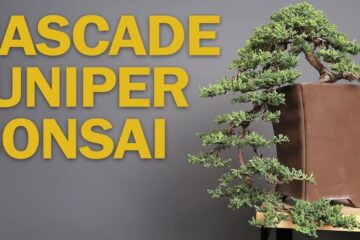The beauty of bonsai depends largely on proper care and formation methods. Shaping the bonsai tree to bring an aesthetic look is challenging. So, you have to be patient, be strategic and be dedicated to get the best results.
Your goal is to get a nice shape at a short height with a thick trunk and bushy foliage. Then you must know; How to shape a bonsai tree?
You can shape how you want your bonsai to look by following two simple methods. Those are trim and wire. And there are three types of pruning that you have to follow one after the other.
There are a few things you need to consider when growing bonsai if you want to be successful with this project. Healthy growth and development of bonsai depends on a solid foundation, root condition and trunk health.
So to get a healthy tree you need to confirm those things first. Read the article to get a step-by-step guide how to shape a bonsai tree.
How to Shape a Bonsai Tree – Beginners Bonsai Shaping Guide
Content Overview
Extra care of the branches of the bonsai tree is essential to give the bonsai a compact shape. To achieve basic bonsai shapes, you must know the right species of tree and the natural growth of the bonsai.
When you understand the natural growth of bonsai, it helps you to properly redesign bonsai plants to manipulate the natural growth into your desired shape. So before learning the process of bonsai shaping let’s know how bonsai grows.
How do bonsai trees grow?
Basically, plants are influenced to grow forward. Hence the progress area is the main important point for growth control. You will definitely notice that the central stem grows faster than the other side stems. So the central trunk of any branch is stronger than any side trunk to control the shape.
This natural growth tells you that the dominant growth of the plant starts from the central stem. So you need to trim the top and outer parts significantly to effect natural dominance. As a result, the tree will be used to redirect its growth to the inside and bottom rather than the front. Thus, you can successfully control the growth direction and shape of the bonsai tree.
Now, you know how the tree will grow, so it’s time to learn how to bring an aesthetic shape to your bonsai.
Method #1 Prune
Pruning is a brilliant way to manage the natural growth of leaves and branches to bring a basic shape. Pruning is also of three types. such as
- Maintenance Pruning
- Structural Pruning
- Root pruning
Type-1 Maintenance Pruning
Maintenance pruning is a proven way to balance and redirect the style and form of a plant. The natural tendency of the plant is to grow mostly on the upper and outer part of the stem. So, to refine the growth you need to trim this area and redirect the growth inwards to give it an aesthetic look and style.
Read More : The Ultimate Guides How to Trim a Japanese Maple
Type-II Structural Pruning
First, you need to choose the branch where you want natural growth and where you want to change the growth type and shape. In this case, structural pruning is very effective for giving basic shape to large branches. You may be confused about which branches to remove and which to keep. Because selection determines how your tree will look.
So, before jumping into the process, spend some time researching. Search the web to check out expert bonsai artists for pruning shapes. Reference works of experts and professional artists will help you a lot to get an idea of the selection.
Best time for structural pruning
The ideal time to apply structural pruning is in late spring or fall. It is best to apply these techniques before the plant’s growing season. So the ideal period depends on your bonsai type. For example, if you have ficus bonsai, the timing is different from juniper bonsai.
Structural Pruning Steps
When you follow certain steps for pruning structures, you will achieve the best results. Here are the steps
- First, place your plants on a table or flat surface at a certain height with your eye level.
- Then critically monitor your bonsai plants to find dead branches. Choose the unwanted branches that need to be removed to achieve the specific style. There are no specific rules for branch selection. It depends on experience and practice to make structural pruning perfect and effective.
- Remove all dead branches and examine the trees carefully to plan your desired design and shape.
- Look closely at the plant and imagine the expected art and do everything necessary to implement the expected shape.
Some helpful tips for efficient structure trimming
Here are some tips for spotting unwanted branches and treating trees after pruning.
- Any branch that obstructs the view of the trunk
- Dead or brown branches
- A branch that crosses another branch
- Branches hanging down or scattered shape
- No branches or suckers from the base trunk
- A branch that closes to the ground
- A branch that tends to grow towards the back of the tree meaning directly towards the trunk
- Inner branches grow upwards
- Parallel branch
- Branches have unwanted twists and a turning point
- Excessively large branches
- If two branches emerge from the same height, remove one
- Any mismatched branches that are awkwardly thick compared to other branches
- Branches shaped like the trunk should also be cut
- When you prune thick branches, there is a high chance of scarring the tree. To avoid these problems, you need to use the right gardening tools like a concave cutter to avoid unwanted spots or blemishes.
- You should also use turmeric powder to seal the wound. It is a natural remedy to keep plants free from infection and help them recover quickly. A healthy bonsai will not experience problems surviving after pruning ⅓ of its leaves and branches.
We have already mentioned that there are no predetermined rules for structural pruning. Just a few tricks to make this task convenient and perfect. We create this list based on the experience of expert bonsai gardeners, so you can easily find which branch to cut to get an aesthetic look.
Type-3 Root Pruning
After implementing maintenance and structural pruning, it’s not a bad idea to think about core pruning. So, if you don’t get the expected shape of your bonsai, you can apply root pruning. But, root pruning is not as simple as maintenance and structure pruning. Root pruning requires some technique.
Best time for root pruning
You should prune the root after 1 year, when the plants have a bright shape. Any deep pruning should be done once a year during this period. So, give the bonsai time to heal from the structural pruning load and then you can do root pruning next year. The growing season is also the right time for root pruning.
Steps of root pruning
There are two types of roots in bonsai. One is an open root, and the other is an underground root. The exposed root is known as nebari and controlling nebari can give your bonsai a unique look. When you see that the Neberry is growing properly and is evenly placed from the trunk, you can start pruning the root.
- First, when pruning roots, you should carefully clip dead and thin roots.
- If you have a pine or conifer bonsai, you will need to clip by hand instead of scissors. Any tool such as a cutter or scissors can shock this species of plant. So avoid any tools to cut those species, or your plant may die.
- Now, cut only unnecessary, thin and dead roots. You should cut the inner roots and the outer roots.
- To reconstruct the external route, you can apply a simple cutting method. Cut off unwanted parts of the bonsai to remove the bark and phloem.
- You also need to cut the cambium under the bark
- However, when cutting the phloem and cambium do not cut any deep part. Because the phloem acts to supply nutrients to the roots and the cambium ensures rapid growth.
- So after cutting, rest the bonsai to give it time to grow.
- You can also apply air layering or grafting to restructure the nebari to enhance the beauty of the bonsai.
The traditional eight aspects of the style are commonly seen in bonsai forms. By training and pruning, you can improve external root development. Everything depends on balance. You can bring an aesthetic view by balancing the external root structure.
Here are some helpful tips for efficient pruning
Since roots are always underground and invisible. So you need to keep some tips in mind for root pruning like a professional gardener.
- Outer roots help give your bonsai an outstanding structure. Here you can apply a maintenance pruning to control the shape of a tree. Therefore, you should start pruning from the branches.
- You should use scissors to clip the outgrowth canopy. Choose the right bonsai tool to make the pruning process easier and avoid any unwanted mistakes or damage to the tree.
- Regular pruning is necessary to encourage natural growth and produce dense foliage. You can also achieve evenly distributed branches with regular pruning.
- Different species of bonsai require different techniques when pruning. So depending on the bonsai species, you need to choose the right tools and techniques. On some trees, you can combine manual clipping and tool clipping to get the best pruning.
- You can also follow defoliation when you prune. This means that bonsai leaves should be removed during summer to grow new leaves. This defoliation pruning helps reduce the size of the leaves and gives the bonsai tree a beautiful appearance.
Method #2 Wiring
It is a functional and technical method to create any compact shape and style using wire. Here you force the branches of the tree to redirect to grow in the direction you expect.
How to Shape a Bonsai Tree Using Wire?
You can achieve different bonsai shapes using different techniques. Wiring is a brilliant idea to bring any kind of bonsai into shape. You need to wrap the branch of the tree with wire to force the branch to redirect the growth as you desire.
It takes months to change the direction of the branch using wiring. After fixing the direction, you need to remove the wire. You can apply single and double wire technique according to the condition of the tree. Let’s find out how you can wire to bring a special style to the bonsai.
- Before wiring, you can do a little pruning to remove dead branches and clip leaves. It is better to cut the leaves with scissors.
- Collect clippers and wire with the correct thickness
- Now, wrap the trunk with wire, then cover the primary branches. After covering the primary branch, the secondary branch should be wired.
- After wiring complete trees are bent to get the perfect shape
- The trunk should be removed after 1-3 months
- This is an overview of the entire wiring process.
Here are some helpful tips to wire efficiently
Now here are some tips to implement the wiring process to get the shape you want.
Wire type
You need to select the right bonsai wire to get the best results. For beginners, anodized aluminum is best because it allows for correction and reapplication. If your tree has bark, you should use aluminum wire for wiring. However, it takes more time to extract the shape but does not create a scar on the stem or bark.
If you want a hardcore bend, you can use copper wire. Copper wire can give you an exact shape because it is stronger than aluminum wire. But you can’t reuse copper wire.
Wire thickness
You must choose the thickness of the wire carefully. It is better to choose thin wire than branches. Wire that comes with ⅓ thickness of the branch is good for wiring. So try to keep the thickness of wire less as per the thickness of your tree.
Wiring method
When wiring a tree, wrap the two nearest branches with a single piece of wire. This is called double wiring method. This helps to give both branches a similar look and shape. However, you can cover the remaining branches with a single wire to get a unique shape. This is a single wire method.
Wiring should be done at a 45° angle to give the branch room to grow. Do not over-tighten the wire as this will damage the bark. Twist the wire snugly on the tree. Bend the branch down and up to suit your style. But the branch you need to bend downwards bends downwards and vice versa.
The Anchor
You can apply an anchor to the trunk for the cable and secure the cable.
Care
After wiring, it is important to shade and fertilize the plants. You can apply both organic fertilizers and liquid fertilizers to ensure healthy growth of bonsai. Observe the tree carefully to avoid any unwanted problems.
Hopefully, you will notice changes within 1-4 months after wiring. Don’t forget to remove the wires with pliers. Otherwise, it can create permanent scars on the skin. Therefore, it is better to cut the wires with pliers rather than pry them.
However, are you not clear about the wiring process, or confused after reading all these steps and tips? No worries mate. You can see another post on how to wire a bonsai tree. There we have described in detail, how to wire bonsai, how to select the wire and how to remove the wire.
Read More : How To Take Care of a bonsai tree
When should I start shaping my bonsai tree?
The right time to apply maintenance pruning techniques is during the growing season. That is, it is best to shape outdoor bonsai from March to September. If you have an indoor bonsai, you should prune it at the end of the year.
The exact time may also vary depending on the shaping method. If you plan to implement wiring, you can do it in any season or day. But it is better to apply it in late winter because, at that time, most of the plants shed their leaves which makes the wiring easier.
FAQs
How do I choose a bonsai shape?
You can play with the bonsai shape and appearance. Do a lot of research to discover your favorite shape. You should grow the bonsai at an angle of 60-80° and try to get the effect.
How long does it take for a bonsai tree to take shape?
It depends on your strategy. If you apply online, you will receive a result within 1-4 months. But if you apply for trimming, it takes more than six months to bring visible shape. Depending on the type of bonsai, the time may also fluctuate.
How to shape a juniper bonsai tree?
Juniper bonsai is a very common and popular bonsai species. You can follow the pruning and wiring method to give your juniper the best shape. The correct time for juniper formation is late winter and early spring.
Final Verdict
Achieving the desired shape of bonsai requires a lot of methods, techniques and efforts. You have to invest your precious time and dedication to bring out an artistic style. We have tried to give you a step by step guide on how to shape a bonsai tree. But there are no shortcuts to bonsai shaping.
To get the best design for your tree, there is no substitute for research. The more you observe the unique art of bonsai, the more you will learn. So be sure to check out the popular and in-demand bonsai shapes.
Be patient, and practice more to gain control over the shape or design. It’s fun to control the bonsai shape and bring out the special look you want.



